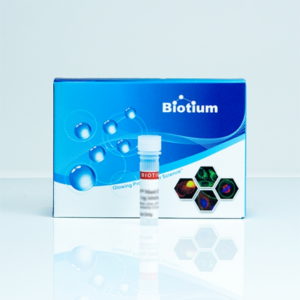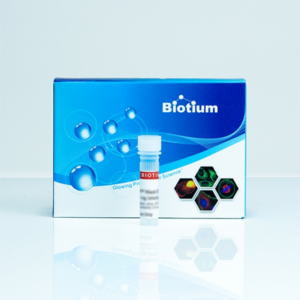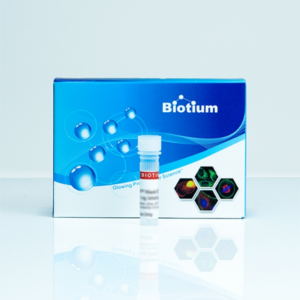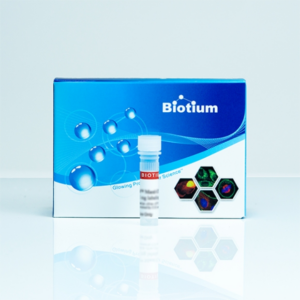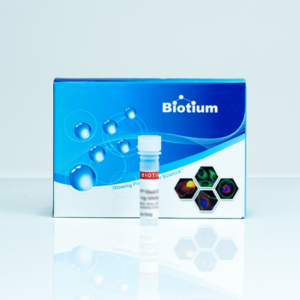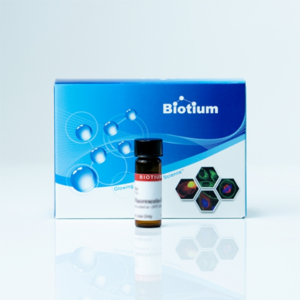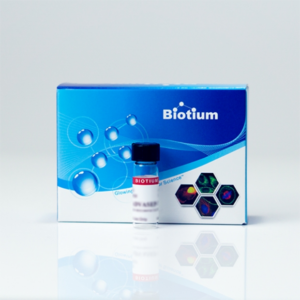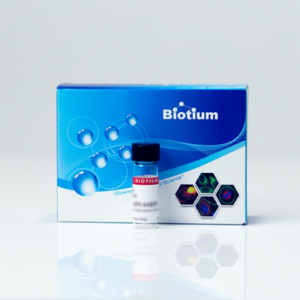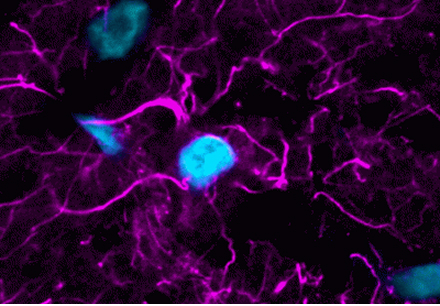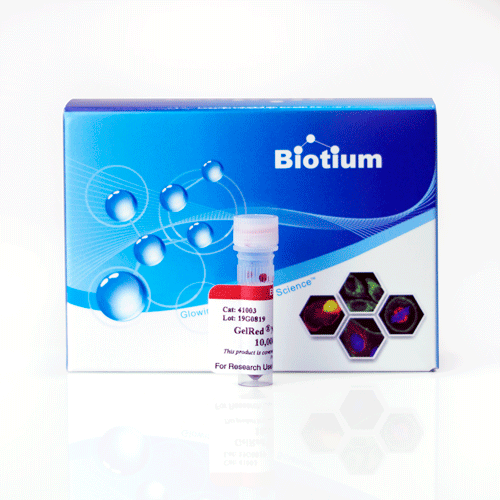Calcium Indicators
To study the roles of calcium in cells, often it is essential to quantitatively monitor its concentration. The most widely used method of Ca2+ detection is by the use of fluorescent indicators, a technique pioneered by Roger Tsien and colleagues. Ca2+ indicators are fluorophores coupled to a BAPTA calcium chelator structure. Binding of Ca2+ to the chelator causes a spectral shift in the dye fluorescence and/or increased dye fluorescence. A variety of indicators are available that vary in their Ca2+ dissociation constants (Kd) or Ca2+ response range, excitation/emission wavelengths, spectral shift, and relative fluorescent quantum yields.
You should select a Ca2+ indicator that best suits your needs in consideration of the biological system, instrument settings, and other fluorescent probes used in the experiment. The indicator Kd values give an estimate of the Ca2+ concentration response, usually 0.1 Kd to 10 Kd, with the caveat that Kd values measured in vitro may differ from those in cells due to differences in ionic strength, pH, viscosity, and Ca2+ buffering by lipids and proteins.
Ratiometric vs. Non-Ratiometric Indicators
Upon binding to calcium, ratiometric indicators undergo a shift either excitation wavelength, emission wavelength, or both. Ca2+ concentration is determined by measuring indicator fluorescence at two different excitation and emission settings (corresponding to the maxima with no Ca2+ and high Ca2+) and determining their ratio. These indicators have the advantage of being internally controlled, and therefore, avoid artifacts from uneven dye loading or photobleaching between samples. Ratiometric measurements may require specialized imaging setups or filter cubes. Non-ratiometric indicators show increased fluorescence intensity upon binding to calcium, with no shift in excitation/emission wavelengths.
Cell Membrane-Permeant AM Esters
In their salt forms, indicators are water-soluble and membrane impermeant, so loading them into cells requires microinjection. AM esters are membrane-permeant forms of indicators that themselves do not bind ions. However, once they have entered cells, they are hydrolyzed by esterases to release the parent ion indicator. Thus, cells or tissues can be loaded with indicator by simply incubating them with a buffer containing the AM ester form. Biotium also supplies Pluronic® F-127, a mild non-ionic detergent that can facilitate cell loading of AM ester compounds, and high grade anhydrous DMSO for preparing AM Ester stock solutions.
Properties of Calcium Indicators
| Indicator | MW1 | Ratiometric? | Excitation2 | Emission2 | Kd3 | Membrane-Impermeant Salts | Membrane-Permeant AM Esters |
|---|---|---|---|---|---|---|---|
| Fluo-3 | 770 | No | 506 nm | 525 nm | 390 nM | Fluo-3, Pentaammonium Fluo-3, Pentapotassium Fluo-3, Pentasodium | Fluo-3, AM Ester Fluo-3 AM Ester, 1 mM in DMSO |
| Fluo-4 | 737 | No | 494 nm | 506 nm | 335 nM | Fluo-4, Pentapotassium | Fluo-4, AM Ester |
| Mag-Fluo-4 | 682 | No | 493 nm | 517 nm | 22 uM | Mag-Fluo-4, Tetrapotassium | Mag-Fluo-4, AM Ester |
| Fura-2 | 642 | Yes | 363/335 nm | 512/505 nm | 145 nM | Fura-2, Pentaammonium Fura-2, Pentapotassium Fura-2, Pentasodium | Fura-2, AM Ester Fura-2, AM Ester, 1 mM in DMSO |
| Indo-1 | 650 | Yes | 349/331 nm | 482/398 nm | 230 nM | Indo-1, Pentaammonium Indo-1, Pentapotassium Indo-1, Pentasodium | Indo-1, AM Ester |
| Furaptra (Mag-Fura-2) | 435 | Yes | 369/330 nm | 511 nm | 1.9 mM (Mg2+) 25 uM (Ca2+) | Furaptra , Pentapotassium Furaptra, Pentasodium | Furaptra, AM Ester |
| Rhod-2 | 755 | No | 556 nm | 576 nm | 1 uM | Rhod-2, Triammonium Rhod-2, Tripotassium Rhod-2, Trisodium | Rhod-2, AM Ester |
| Rhod-590 | 912 | No | 595 nm | 616 nm | 610 nM | Rhod-590, Tripotassium | Rhod-590, AM Ester |
2. For non-ratiometric indicators, Ex/Em with calcium is shown; for ratiometric indicators, wavelengths with no calcium/high calcium are shown
3. Ca2+ dissociation constant measured at 22°C, pH 7.2 buffer
Calcium & Other Ion Chelators
Calcium Chelators
BAPTA and its derivatives are calcium chelators that are commonly used to generate calcium buffers with well-defined calcium concentrations. By introducing the chelators into cells, one can control the cytosolic calcium concentration, an important means to study the roles of calcium.
Key advantages of these calcium chelators include relative insensitivity toward intracellular pH change and fast release of calcium. Biotium offers several BAPTA chelators with calcium dissociation constants covering the biologically significant range from 10-7 to 10-2 M.
We offer membrane-impermeant salts of BAPTA chelators for microinjection, or cell-permeant AM ester forms of the chelators that can be loaded into cells by incubation.
Heavy Metal Chelators
TPEN (Cat. No. 59003) is an excellent heavy metal chelator that does not affect calcium, magnesium, sodium, or potassium concentrations. Therefore it is useful tool for distinguishing the effects of heavy metals like zinc, iron, copper, and manganese on fluorescent indicators for calcium, magnesium, sodium and potassium.
Properties of BAPTA Chelators
| Chelator | MW1 | Kd2 | Membrane-Impermeant Salts | Membrane-Permeant AM Esters |
|---|---|---|---|---|
| BAPTA | 477 | No Mg2+: 0.59 mM 1 mM Mg2+: 0.70 mM | BAPTA, Tetracesium BAPTA, Tetrapotassium BAPTA, Tetrasodium | BAPTA, AM Ester |
| 5,5'-Dibromo BAPTA | 635 | No Mg2+: 3.6 mM | 5,5'-Dibromo BAPTA, Tetrapotassium | -- |
| 5,5'-Difluoro BAPTA | 513 | No Mg2+: 0.61 mM 1 mM Mg2+: 0.72 mM | 5,5'-Difluoro BAPTA, Tetrapotassium | 5,5'-Difluoro BAPTA, AM Ester |
| 5,5'-Dimethyl BAPTA | 505 | No Mg2+: 0.16 mM 1 mM Mg2+: 0.44 mM | 5,5'-Dimethyl BAPTA, Tetrapotassium | 5,5'-Dimethyl BAPTA, AM Ester |
| 5-Mononitro BAPTA | 522 | No Mg2+: 0.94 mM | -- | -- |
| 4-Trifluoromethyl BAPTA | 545 | No Mg2+: 0.57 mM | -- | -- |
2 Cell Calcium 10, 491 (1989).
Calcium Calibration Buffers, Ionophores, & Reagents
Calcium Calibration Buffers
Accessory Reagents for Indicator Dyes
Calcium Ionophores and Caged Calcium
Calcium ionophores facilitate the equilibration of calcium across cellular membranes and are used to calibrate calcium indicators or alter intracellular calcium concentration.
A-23187 (calcimycin, calcium ionophore III) equilibrates intracellular and extracellular calcium, is used for in situ calibration of fluorescent calcium indicators, and also Mn2+ to enter the cells and quench intracellular fluorescence of calcium indicators.
Ionomycin is used to modify intracellular calcium concentrations, calibrate fluorescent calcium indicators, and stimulate cytokine production and cell proliferation in lymphocytes. In other cell types it can induce apoptosis and inhibit proliferation.
DMNP-EDTA (DM-Nitrophen™) is a caged Ca2+ chelator. UV light cleaves the chelator to release calcium. Upon photolysis, the Kd for Ca2+ increases from 5 nM to 3 mM, resulting in a pulse of free Ca2+.
Calcium Ionophores & Accessory Reagents
| Product | Catalog number | Size |
|---|---|---|
| Calcium Calibration Buffer Kit | 59100 | 50 mL each buffer |
| A-23187 Free Acid | 59001 | 1 mg |
| 4-Bromo A-23187, Free Acid | 59006 | 1 mg |
| Ionomycin, Calcium Salt | 59007 | 1 mg |
| DMNP-EDTA, Tetrapotassium Salt | 50050 | 5 mg |
| DMNP-EDTA (Caged Calcium), AM Ester | 50051 | 1 mg, 5 mg |
| EDC (EDAC) | 59002 | 100 mg |
| Pluronic® F-127 | 59000 | 1 g |
| Pluronic® F-127, 20% in DMSO | 59004 | 1 mL |
| Pluronic® F-127, 10% in H2O | 59005 | 30 mL |
| Probenecid, Sodium Salt, Water Soluble | 50027 | 10 x 77 mg |
| DMSO, Anhydrous | 90082 | 10 mL |
Other Ion Indicators
Chloride Indicators
The fluorescence of SPQ 6(-methoxy-N-(3-sulfopropyl)quinolinium) is specifically quenched by chloride via collision. Therefore, chloride concentration is measured by monitoring the degree of fluorescence decrease. The dye can be loaded into cells by hypotonic shock. The dye has excitation/emission at 344/443 nm.
MQAE (N-(ethoxycarbonylmethyl)-6-methoxyquinolinium bromide) is an improved chloride indicator that has greater sensitivity to chloride (Ksv= 200 M-1) than SPQ (Ksv= 118 M-1) and higher fluorescence quantum yield. The ester group of MQAE may slowly hydrolyze inside cells, resulting in a change in its fluorescence response. The dye has excitation/emission at 350/460 nm.
Zinc Indicators
Zinc is believed to be involved in the suppression of apoptosis and play important roles in many neural activities. Zinquin is an UV-excitable, blue fluorescent zinc indicator with excitation/emission maxima at 350/460 nm. Biotium offers two variations of Zinquin that differ in cell permeability. Zinquin free acid is a membrane-impermeant form, while Zinquin ethyl ester is membrane-permeant and is hydrolyzed into Zinquin free acid after entering cells.
Also see Accessory Reagents for Indicator Dyes.
Chloride & Zinc Indicators
| Product | Indicator | Membrane permeability | Ex/Em | Catalog number | Unit size |
|---|---|---|---|---|---|
| SPQ | Chloride | Impermeant | 344/443 nm | 52010 | 50 mg |
| MQAE | Permeant | 350/460 nm | 52011 | 100 mg | |
| Zinquin free acid | Zinc | Impermeant | 350/460 nm | 52022 | 5 mg |
| Zinquin ethyl ester | Permeant | 350/460 nm | 52020 | 5 mg |
pH Indicators
BCECF pH Indicators
BCECF is the most widely used fluorescent pH sensor. With a pKa of 6.97, close to physiological pH, it can detect changes in cytosolic pH with high sensitivity. At low pH, the dye is weakly fluorescent but becomes more fluorescent with increasing pH. The excitation spectrum of the dye undergoes a slight shift with pH change, while the wavelength of the emission maximum remains unchanged. The pH is determined ratiometrically by the relative fluorescent intensities at 535 nm when the dye is excited at 439 nm and 505 nm. Available in membrane-impermeant free acid and cell-permeant AM ester forms.
Flubida and Flubi-2 pH Indicators
Flubida-2 has been used to detect pH at a specific site in a cell, such as cell organelles, by directing the probe to where avidin-chimera proteins are located. The probe is a conjugate of biotin and fluorescein diacetate, which is nonfluorescent until the probe has entered the cells and is hydrolyzed by cellular esterases. Flubida-2 is membrane-permeant and can be delivered into cells via simple incubation. Flubi-2 is the membrane-impermeant hydrolyzed product of Flubida-2. Its spectral properties and pH response are similar to those of BCECF.
Carboxyfluorescein pH Indicators
Carboxyfluorescein (FAM) has a pKa of 6.5 and can be used as a pH indicator or cellular tracer. Its excitation spectrum and fluorescence response to pH are similar to those of BCECF. Carboxyfluorescein is also available in membrane-permeant diacetate form (CFDA). CFDA-SE is a membrane-permeant amine-reactive form that covalently reacts with cytoplasmic proteins for stable labeling.
5-(and-6)-Carboxy-2′,7′-dichlorofluorescein is similar to carboxyfluorescein, but has a pKa of 4.8, and is useful for detecting pH in more acidic environments. It is also available in membrane-permeant diacetate, and membrane-permeant, amine-reactive diacetate succinimidyl ester forms.
The pKa of 5-carboxy-2’,7’-dichlorosulfonefluorescein is near 4.0 and the dye may be a pH indicator for acidic organelles.
Fluorescein derivatives are available as single isomer or mixed isomers; the isomers have the same spectral properties. For certain coupling reactions, single isomer may be preferable, but mixed isomers are suitable for most applications.
Membrane-Permeant pH Indicators
| Product | pKa | Catalog number | Unit size |
|---|---|---|---|
| BCECF AM Ester, 1 mg/mL in DMSO | pKa 6.97 | 51009 | 1 mL |
| BCECF AM Ester | 51011 51011-1 51012 | 10 x 100 ug 20 x 50 ug 1 mg |
|
| 5-Carboxyfluorescein diacetate, single isomer (5-CFDA) | pKa 6.5 | 51018 | 100 mg |
| 6-Carboxyfluorescein diacetate, single isomer (6-CFDA) | 51021 | 100 mg | |
| 5-(and 6)-Carboxyfluorescein diacetate, mixed isomers (5(6)-CFDA) | 51014 | 100 mg | |
| 5-(and-6)-Carboxyfluorescein diacetate, succinimidyl ester (CFDA, SE) | 90041 | 25 mg | |
| Flubida-2 | 51022 | 2 mg | |
| 5-(and-6)-Carboxy-2′,7′-dichlorofluorescein diacetate | pKa 4.8 | 51016 | 100 mg |
| 5-(and-6)-Carboxy-2′,7′-dichlorofluorescein diacetate, succinimidyl ester (SE) | 90040 | 25 mg |
Membrane-Impermeant pH Indicators
| Product | pKa | Catalog number | Unit size |
|---|---|---|---|
| BCECF, free acid | pKa 6.97 | 51010 | 1 mg |
| 5-Carboxyfluorescein (5-FAM, single isomer) | pKa 6.5 | 51019 | 100 mg |
| 6-Carboxyfluorescein (6-FAM, single isomer) | 51020 | 100 mg | |
| 5-(and-6)-Carboxyfluorescein (5(6)-FAM, mixed isomers) | 51013 | 100 mg | |
| Flubi-2 | 51024 | 5 mg | |
| 5-Carboxy-2′,7′-dichlorofluorescein | pKa 4.8 | 51017 | 100 mg |
| 5-(and-6)-Carboxy-2′,7′-dichlorofluorescein | 51015 | 200 mg | |
| 5-Carboxy-2′,7′-dichlorosulfonefluorescein | pKa 4 | 51023 | 10 mg |

